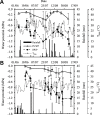Modeling Stem Water Potential by Separating the Effects of Soil Water Availability and Climatic Conditions on Water Status in Grapevine (Vitis vinifera L.)
- PMID: 31824529
- PMCID: PMC6883387
- DOI: 10.3389/fpls.2019.01485
Modeling Stem Water Potential by Separating the Effects of Soil Water Availability and Climatic Conditions on Water Status in Grapevine (Vitis vinifera L.)
Abstract
Measuring seasonal plant water status is critical in choosing appropriate management strategies to ensure yields and quality of agricultural products, particularly in a context of climate change. Water status of grapevines is known to be a key factor for yield, grape composition, and wine quality. Predawn leaf water potential (PLWP) and stem water potential (SWP) proved to be simple and precise indicators for assessing grapevine water status and subsequent same-day spatial comparisons. A drawback of SWP is that it does not allow for temporal comparisons, because the measured value is impacted both by soil water availability and climatic conditions on the day of measurement. The objectives of this study are i) to provide a model that separates the effect of soil water content from the effect of climatic conditions on the SWP value and ii) to standardize the SWP value to a value under predefined reference climatic conditions in order to compare SWP values collected under different climatic conditions. SWP and PLWP were temporally assessed on three soil types in Saint-Émilion (Bordeaux, France) in 2015 and on five soil types in Margaux (Bordeaux, France) in 2018 using a pressure chamber. SWP measurements on two consecutive days with contrasting climatic conditions allowed to assess the impact of these conditions on SWP values. A large portion of the variability in SWP values was explained by PLWP. Model selection further showed that the addition of maximum air temperature and seasonality explained a significant amount of the remaining variability in SWP values. SWP values could be successfully standardized to a theoretical value under reference climatic conditions, which allows for temporal comparisons of SWP values. A plant-based measurement, such as the water potential, can be considered as the most straightforward indicator of plant water status as it integrates the effects of soil, plant, and atmospheric conditions. More precise interpretation of SWP values provides winegrowers with a tool to more adequately implement short- and long-term management strategies to adapt to drought in order to ensure yield and grape quality.
Keywords: grapevine; maximum air temperature; modeling; predawn leaf water potential; stem water potential; water status.
Copyright © 2019 Suter, Triolo, Pernet, Dai and Van Leeuwen.
Figures





References
-
- Abrisqueta I., Conejero W., Valdés-Vela M., Vera J., Ortuño M. F., Ruiz-Sánchez M. C. (2015). Stem water potential estimation of drip-irrigated early-maturing peach trees under Mediterranean conditions. Comput. Electron. Agric. 114, 7–13. 10.1016/j.compag.2015.03.004 - DOI
-
- Abtew W., Melesse A. (2013). "Vapor pressure calculation methods", in Evaporation and evapotranspiration (Dordrecht: Springer Netherlands; ), 53–62. 10.1007/978-94-007-4737-1_5 - DOI
-
- Améglio T., Archer P., Cohen M., Valancogne C. (1999). Significance and limits in the use of predawn leaf water potential for tree irrigation. Plant Soil 207, 155–167. 10.1023/A:1026415302759 - DOI
-
- Bois B., Joly D., Quénol H., Pieri P., Gaudillère J.-P., Guyon D., Saur E., Van Leeuwen C. (2018). Temperature-based zoning of the Bordeaux wine region. OENO One 52, 1–16. 10.20870/oeno-one.2018.52.4.1580 - DOI
-
- Chaves M. M., Santos T. P., Souza C. R., Ortuño M. F., Rodrigues M. L., Lopes C. M. (2007). Deficit irrigation in grapevine improves water-use efficiency while controlling vigour and production quality. Ann. Appl. Biol. 150, 237–252. 10.1111/j.1744-7348.2006.00123.x - DOI
LinkOut - more resources
Full Text Sources

